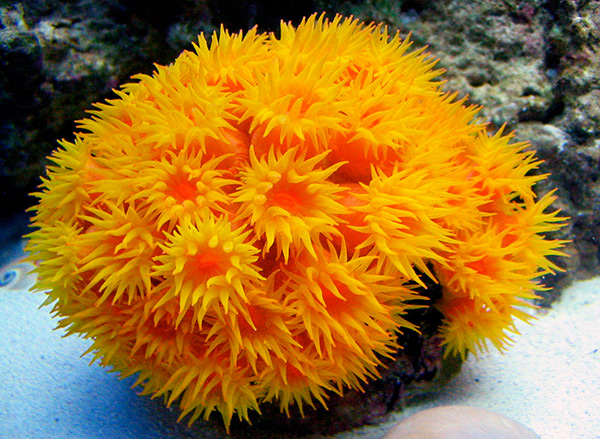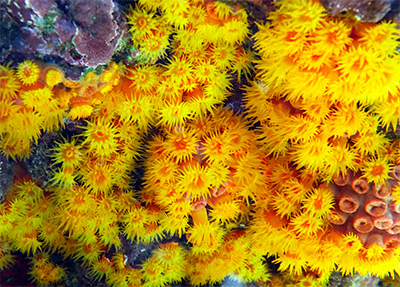When ascribed to the various species of the genus Tubastraea, the common name “sun coral” is both fitting and ironic. It’s fitting when you consider that the spectacular polyps of many Tubastraea species can quite justifiably be described as sun-like in both color and shape. On the other hand, it’s ironic in that these species, unlike so many of the corals that grace our aquariums, lack symbiotic zooxanthellae and, therefore, don’t depend on sunlight—or intense reef-grade aquarium lighting—for their sustenance.
Having no special lighting needs might seem to suggest that these corals would be a good choice for the novice reefkeeper. However, just the opposite is actually true. Tubastraea are heavy feeders that require a high level of commitment and exceptional husbandry skills and are generally best left to more advanced hobbyists.
Physical traits
Tubastraea spp. are considered large-polyp stony (LPS) corals, with several species possessing striking yellow to orange polyps that emerge from tubular, and in some cases branching, corallites. There are also darker-polyped species that appear in the aquarium trade from time to time, such as T. micrantha, aka the black sun coral, which has olive-green to blackish polyps and tissues.
Being zooplanktivores, Tubastraea spp. corals typically extend their polyps after dark—when plankton tends to be most abundant in the water column—and remain contracted during daylight hours. However, with persistence, it may be possible to persuade a specimen to extend its polyps and feed during daylight hours.
Feeding
For most of the corals we keep, direct feeding tends to be a secondary consideration after providing appropriate lighting. But when it comes to Tubastraea spp., targeted feeding is absolutely essential. Small meaty items, such as mysid shrimp, enriched brine shrimp, finely chopped seafoods, or similar offerings are best.
Specimens must be fed very frequently—ideally every day—and it’s important to ensure that each polyp in the colony gets food. Thus, rather than dose the tank with plankton and leave to chance whether the coral gets enough to eat, it’s best to deliver food directly to each of the polyps using something like a turkey baster, pipette, or eye dropper.

A few additional points to consider with respect to feeding Tubastraea spp.:
- Ease of access for targeted feeding must be taken into consideration when determining where to place these corals in an aquarium system.
- Hungry piscine tankmates may attempt to steal food from the tentacles of these corals, depriving them of adequate nutrition. If fish are present in the same tank, it may be necessary to feed them ahead of time so they’re not so ravenous and/or impede their access to the coral at mealtimes with some sort of feeding enclosure (e.g., an inverted strawberry basket or the top half of a plastic soda bottle).
- The constant heavy feedings necessary to sustain these and many other azooxanthellate corals can quickly foul your aquarium water, so robust protein skimming and frequent water changes are essential.
Current and lighting
Tubastraea spp. are commonly found in areas with fairly robust water movement, which improves the likelihood of plankton reaching their waiting tentacles, so you’ll want to provide moderate to strong flow in captivity as well.
Tubastraea can adapt to different lighting schemes and, contrary to popular misconception, don’t need to be sheltered from light exposure. That was the erroneous impression I used to function under until some years ago when I read the following in Eric Borneman’s Aquarium Corals: Selection, Husbandry, and Natural History: “Most aquarists place these corals under ledges or overhangs in an attempt to mimic their natural locale. Unfortunately, such placement often subjects them to areas of low current, contrary to the conditions they prefer in nature. The presence of light does not harm Tubastraea, and they may be kept in the open, exposed to full light.”
The only caveat I might add here is that if a Tubastraea is being moved to a system with a significantly different level of light intensity, you’ll want to make the transition gradually to avoid shocking the specimen.
A dedicated system?
Considering the specialized feeding requirements of Tubastraea corals, it might be easiest to keep them in a dedicated species tank focused exclusively on their needs rather than in a typical mixed reef aquarium.



